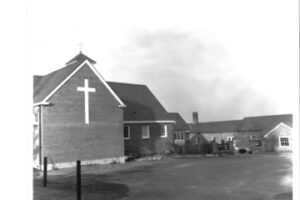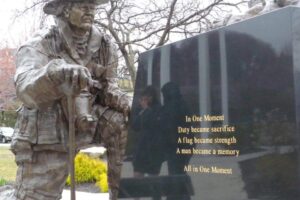How many of us are so busy with our lives that we see how fast we can negotiate the curves around the Tarrytown Lakes as we hurry to get home? I was doing just that recently when I noticed floodlights on the lake as people were ice skating.
This brought on three very vivid memories.
Probably my first memory was of feeding the ducks when I was very young child. That led to further memories of fishing on the lower lake with my father and brother in the summer. But as I thought back to years long ago, I realized that my fondest memories were of skating at night with friends as music played over the loudspeakers. It seemed so much more exciting to be skating at night. Later on, I was very surprised to learn that the lakes were man-made, because I had presumed that it was one big natural lake with a causeway separating it for traffic to pass. In a rather condensed history, this is how they came to be.
Before 1876, the Tarrytown water supply was derived from a series of scattered wells. In February 1876, there was a large fire that destroyed 19 buildings on lower Main and Orchard Streets. The fire had spread rapidly due to a lack of water pressure for fire fighting. Action had to be taken and the Board of Trustees met in August of that year to come up with a plan that would cost approximately $14,000 and was to be paid by tax levy. A reservoir was to be constructed at the intersection of Rose Hill and Union Avenue. The reservoir was a covered structure that was 50 feet long, 40 feet wide, and 15 feet deep. Water for fire prevention was pumped from the Andre Brook at what was once New Street just west of Orchard Street. (The Andre Brook runs through Patriot’s Park and is the boundary that separates Tarrytown and Sleepy Hollow.) In 1881, an additional $9000 was raised to pump drinking water to the reservoir. It was supplied by a 600 foot artesian well dug on Neperan Road and supplied 225,000 gallons. A few years later, the flow of water from this well was disrupted by heavy blasting that had begun for the construction of the new Croton Aqueduct. In addition, the population of Tarrytown was growing necessitating more drinking water. The reservoir still exists under the road today, but a new plan was needed. A temporary solution was the digging of another artesian well at what is now the site of the Hilton Inn. The Tarrytown Trustees then began to think about Storm Brook Stream which had a higher elevation (greater water pressure) and flowed into the Saw Mill River east of Tarrytown. On August 15, 1887 a bond for $100,000 was passed by voters, with the generous assistance of millionaire Jay Gould of Lyndhurst. Land was to be acquired in what was called the Swampy Brook Valley in preparation for the building of the Tarrytown Lakes and some families had to be relocated. Two artesian wells were drilled, a power house was built and a 24- foot-high dam was constructed blocking the Storm Brook where the valley narrowed just west of the hamlet of Eastview. The valley filled with water and the reservoir was completed with a spillway for excess water flow. The Tarrytown Lakes were completed in November 1888. The Upper Lake approximately 20 acres and held 30 million gallons of water. The Lower Lake is approximately 50 acres and held 170 million gallons. The entire project exceeded cost to $425,000 and was supplemented through further bond issue.
Today, 116 years later, the Tarrytown Lakes again overflow east to the Saw Mill River as no water is taken from them. By the early nineties the old pump house, was in great need of updating and it was seen as too expensive to do so. Starting in 1993 Tarrytown’s water has been supplied completely by the Catskill System which is owned by New York City. Approximately 3 million gallons daily are pumped in the summer and 2 million in the winter under the supervision of Steve Cowles at the new Water Treatment Plant/Pumping Station on the north side of the lower lake.






